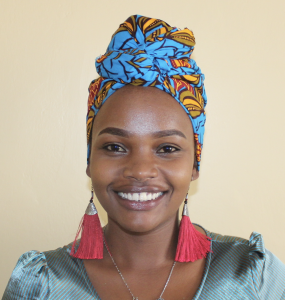The roads leading up to Shamoni Community are bumpy and dusty. The area is green with sugarcane and maize plantations, for which the village is known. Most houses in the area are semi-permanent. Shamoni Center is nearby, where the local farmers take their goods for sale and exchange. Some people here work as small business owners while others are carpenters and teachers. The majority, however, plant and sell maize and sugarcane on a large scale. The West Sugar Company is just a few kilometers from this community, driving the local industry. Shamoni Secondary School is also along the way to Shiundu Spring.
Shiundu Spring serves 245 people in Shamoni, but it is not meeting their daily water needs due to its contaminated water and difficult access. The water point is open to agents of contamination including farm chemicals, animal waste, and dirt brought in by surface runoff from the rains. Insects and tiny frogs are visible in the water, as are sand particles. Animals like goats, dogs, and other livestock will wander straight through the water, drinking directly from the source and leaving their waste around the water point. The area is not hygienic.
Community members say their most commonly reported water-related illnesses include sore throats, constant coughs, typhoid, and diarrhea. Time spent at home sick means time lost at work and on the farm, or in school for children. Families drain their resources seeking medical care, diverting money that was intended for other crucial needs such as business and farm investments, or their children's school fees.
Accessibility is the other major issue at the spring. 51-year-old Janet Shiundu Koko attested that Shiundu Spring has always had a lot of water, and it has never run dry. As a result, it is sought after by many for reliable water, especially in the dry season. But it is difficult to accommodate crowds at the spring because the entire area stands several inches deep in murky water.
"I have to remove my shoes first because I have to step in the cold and dirty water for me to access it, which is not fun," said teenager Josephine.
Snakes and dangerous insects can easily hide in the water, adding to the risk and discomfort at the spring. To aid in fetching water, community members have tried to improvise a discharge pipe by wedging a plastic pipe between some rocks and sheet metal near the spring's source. But the pipe is not capturing all of the spring's water, leading to slower fill-times for community members' jerrycans. The frequent rains will sometimes wash away the makeshift setup, adding to the time it takes people to fetch water as they try to rebuild it and wait for the extra mud and sand to settle from the disturbance.
The fetching process at Shiundu Spring is causing unnecessary stress and delays to people's daily routines, costing them in productive work time at home, at work, on the farm, and on schoolwork among children. The community is ready to make a change, and we are ready to help them.
What We Can Do:
Spring Protection
Protecting the spring will help provide access to cleaner and safer water and reduce the time people have to spend to fetch it. Construction will keep surface runoff and other contaminants out of the water. With the community’s high involvement in the process, there should be a good sense of responsibility and ownership for the new clean water source.
Fetching water is a task predominantly carried out by women and young girls. Protecting the spring and offering training and support will, therefore, help empower the female members of the community by freeing up more of their time and energy to engage and invest in income-generating activities and their education.
Training on Health, Hygiene, COVID-19, and More
To hold trainings during the pandemic, we work closely with both community leaders and the local government to approve small groups to attend training. We ask community leaders to invite a select yet representative group of people to attend training who will then act as ambassadors to the rest of the community to share what they learn. We also communicate our expectations of physical distancing and wearing masks for all who choose to attend.
The training will focus on improved hygiene, health, and sanitation habits in this community. We will also have a dedicated session on COVID-19 symptoms, transmission routes, and prevention best practices.
With the community’s input, we will identify key leverage points where they can alter their practices at the personal, household, and community levels to affect change. This training will help to ensure participants have the knowledge they need about healthy practices and their importance to make the most of their water point as soon as water is flowing.
Our team of facilitators will use a variety of methods to train community members. Some of these methods include participatory hygiene and sanitation transformation, asset-based community development, group discussions, handouts, and demonstrations at the spring.
One of the most important issues we plan to cover is the handling, storage, and treatment of water. Having a clean water source will be extremely helpful, but it is useless if water gets contaminated by the time it is consumed. We and the community strongly believe that all of these components will work together to improve living standards here, which will help to unlock the potential for these community members to live better, healthier lives.
We will then conduct a small series of follow-up trainings before transitioning to our regularly scheduled support visits throughout the year.
Training will result in the formation of a water user committee, elected by their peers, that will oversee the operations and maintenance of the spring. The committee will enforce proper behavior around the spring and delegate tasks that will help preserve the site, such as building a fence and digging proper drainage channels. The fence will keep out destructive animals and unwanted waste, and the drainage will keep the area’s mosquito population at a minimum.

 Protected Spring
Protected Spring
 Rehabilitation Project
Rehabilitation Project








































